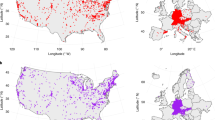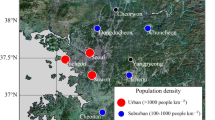Abstract
The effect of towns on plant phenology, i.e. advancement of spring development compared with a rural environment, via the urban heat island (UHI) phenomenon, has been shown for many towns in many countries. This work combines experimental and observational methodology to provide a better and deeper view of climatic habitat in an urban context with a view to understanding the relationship between plant development and urban climate on the intra-urban scale (by taking into account town structure). A dense network of 17 meteorological stations was set up in Rennes, France, enabling us to identify and quantify climatic changes associated with the UHI. Meanwhile, phenological observations were made during early spring (March and April) in 2005 on Platanus acerifolia and Prunus cerasus to study the relationship between climatic and phenological data. The results show that there is both a climatic gradient and a developmental gradient corresponding to the type of urbanisation in the town of Rennes. The town influences plant phenology by reducing the diurnal temperature range and by increasing the minimum temperature as one approaches the town centre. The influence of ground cover type (plants or buildings) on development is also shown. The developmental phases of preflowering and flowering are influenced to differing extents by climatic variables. The period during which climatic variables are effective before a given developmental phase varies considerably. The preflowering phases are best correlated with the mean of the minimum air temperature for the 15-day period before the observation, whereas flowering appears to be more dependent on the mean of the daily diurnal temperature range for the 8 days preceding the observation.







Similar content being viewed by others
References
Aerts R, Cornelissen JHC, Dorrepaal E (2006) Plant performance in a warmer world: general responses of plants from cold, northern biomes and the importance of winter and spring events. Plant Ecol 182:65–77
Benedict C, Geisler M, Trygg J, Huner N, Hurry V (2006) Consensus by Democraty. Using meta-analyses of microarray and genomic data to model the cold acclimatation signaling pathway in Arabidopsis. Plant Physiol 141:1219–1232, doi:10.1104/pp.106.083527
Cantat O (1989) Contribution à l’étude des variations du bilan d’énergie en région parisienne. Essai sur les bilans d’énergie dans les grandes métropoles. PhD Thesis, University Paris-4, 362 p and 254 p
Carrega P (1994) Topoclimatologie et habitat. Revue d’Analyse Spatiale Quantitative et Appliquée, Th. Et., 35 & 36
Chmielewski FM, Rotzer T (2001) Response of tree phenology to climate change across Europe. Agric For Meteorol 108:101–112, doi:10.1016/S0168-1923(01)00233-7
Clergeau P, Croci S, Jokimäki J, Kaisanlahti-Jokimäki ML, Dinetti M (2006) Avifauna homogenisation by urbanisation: Analysis at different European latitudes. Biol Conserv 127:336–344, doi:10.1016/j.biocon.2005.06.035
Daniel H, Lecamp E (2004) Distribution of three indigenous fern along a rural-urban gradient in the city of Angers, France. Urban For Urban Green 3:19–27, doi:10.1016/j.ufug.2004.04.001
Davis Instrument Corp (2000) Davis Weather Monitor II Owner’s Manual. Davis Instruments, Hayward, USA
Defila C (1991) Pflanzenphänologie der Schweiz. Veroeffentlichungen, Switzerland
Defila C, Clot B (2001) Phytophenological trends in the Swiss Alps. Int J Biometeorol 45:203–207, doi:10.1007/s004840100101
Defila C, Jeanneret J (2007) Phänologie —ein Biomonitoring und seine Anwendungen Schweiz. Z Forstwes 5:98–104, doi:10.3188/szf.2007.0098
Dreyer LL, Esler KJ, Zietsman J (2005) Flowering phenology of South African Oxalis—possible indicator of climate change? S Afr J Bot 72:150–156, doi:10.1016/j.sajb.2005.06.009
Escourou G (ed) (1981) Climat et environnement. Les facteurs locaux du climat. Masson, Paris
Fitter AH, Fitter RSR (2002) Rapid changes in flowering time in British plants. Am Assoc Adv Sci 296:1689–1691
Halliday KJ, Salter MG, Thingnaes E, Whitelam GC (2003) Phytochrome control of flowering is temperature sensitive and correlates with expression of the floral integrator FT. Plant J 33:875–885, doi:10.1046/j.1365-313X.2003.01674.x
Heide OM (2008) Interaction of photoperiod and temperature in the control of growth and dormancy of Prunus species. Sci Horticult 115:309–314, doi:10.1016/j.scienta.2007.10.005
Kvaalen H, Johnsen O (2007) Timing of bud set in Picea abies is regulated by a memory of temperature durind zygotic and somatic embryogenesis. New Phytol 177:49–59
Lee DO (1992) Urban warming? An analysis of recent trends in London’s heat island. Weather 47:50–56
Linderholm HW (2006) Growing season changes in the last century. Agric For Meteorol 137:1–14, doi:10.1016/j.agrformet.2006.03.006
Lu P, Yu Q, Liu J, Lee X (2006) Advance of tree-flowering dates in response to urban climate change. Agric For Meteorol 138:120–131, doi:10.1016/j.agrformet.2006.04.002
Luo Z, Sun OJ, Ge Q, Xu W, Zheng J (2007) Phenological responses of plants to climate change in an urban environment. Ecol Res 22:507–514, doi:10.1007/s11284-006-0044-6
Menzel A (2000) Trends in phenological phases in Europe between 1951 and 1996. Int J Biometeorol 44:76–81, doi:10.1007/s004840000054
Menzel A, Estrella N, Fabian P (2001) Spatial and temporal variability of the phenological seasons in Germany from 1951 to 1996. Glob Change Biol 7:657–666, doi:10.1046/j.1365-2486.2001.00430.x
Menzel A, Sparks TH, Estrella N, Koch E, Aasa A, Ahas R, Alm-Kübler K, Bissolli P, Braslavská O, Briede A, Chmielewski FM, Crepinsek Z, Curnel Y, Dahl A, Defila C, Donnelly A, Filella Y, Jatczak K, Måge F, Mestre A, Nordli Ø, Peñuelas J, Pirinen P, Remiová V, Scheifinger H, Striz M, Susnik S, Van Vliet AJH, Wielgolaski F-E, Zach S, Zust A (2006) European phenological response to climate change matches the warming pattern. Glob Change Biol 12:1–8, doi:10.1111/j.1365-2486.2006.01193.x
Myking T (1997) Effects of constant and fluctuating temperature on time to budburst in Betula pubescens and its relation to bud respiration. Trees (Berl) 12:107–112
Nieddu G, Giunta F, Mulas M (1990) Influence of postdormant temperatures on bloom time of four almond cultivars. Sci Horticult 43:63–67, doi:10.1016/0304-4238(90)90037-F
Oke TR (ed) (1987) Boundary layer climates, 2nd edn. Routledge, London
Peiling L, Qiang Y, Jiandong L, Xuhui L (2006) Advance of tree-flowering dates in response to urban climate change. Agric For Meteorol 138:120–131, doi:10.1016/j.agrformet.2006.04.002
Pellissier V, Rozé F, Aguejdad R, Quénol H, Clergeau P (2008) Relationship between the soil seed bank, vegetation and soil fertility along an urbanisation gradient. Appl Veg Sci 11:325–333
Peñuelas J, Fillela I, Zhang X, Llorens L, Ogaya R, Lloret F, Comas P, Estiarte M, Terradas J (2003) Complex spatiotemporal phenological shifts as a response to rainfall changes. New Phytol 161:837–846, doi:10.1111/j.1469-8137.2004.01003.x
Roetzer T, Wittenzeller M, Haeckel H, Nekovar J (2000) Phenology in Central Europe- differences and trends of spring phenophases in urban and rural areas. Int J Biometeorol 44:60–66, doi:10.1007/s004840000062
Schwartz MD (1999) Advancing to full bloom: planning phenological research for the 21st century. Int J Biometeorol 42:113–118, doi:10.1007/s004840050093
Setiyono TD, Weiss A, Specht J, Bastidas AM, Cassman KG, Dobermann A (2006) Understanding and modeling the effect of temperature and daylength on soybean phenology under high-yield conditions. Field Crops Res 100:257–271, doi:10.1016/j.fcr.2006.07.011
Shochat E, Warren PS, Faeth SH, McIntyre NE, Hope D (2006a) From patterns to emerging processes in mechanistic urban ecology. Trends Ecol Evol 21:186–191, doi:10.1016/j.tree.2005.11.019
Shochat E, Wareen PS, Faeth SH (2006b) Future directions in urban ecology. Trends Ecol Evol 21:661–662, doi:10.1016/j.tree.2006.09.007
Smith H, Whitelam GC (1997) The shade avoidance syndrome: multiple response mediated by multiple phytochromes. Plant Cell Environ 20:840–844, doi:10.1046/j.1365-3040.1997.d01-104.x
Sparks TH, Jeffree EP, Jeffree CE (2001) An examination of the relationship between flowering times and temperatures at the national scale using long-term phenological records for the UK. Int J Biometeorol 44:82–87, doi:10.1007/s004840000049
Stewart D, Love W (1968) A general canonical correlation index. Psychol Bull 70:160–163, doi:10.1037/h0026143
United Nation Population Division (eds) (2008) World urbanization prospects: the 2007 Revision. Executive summary. U.N. Department of Economic and Social Affairs, New York
Vallet J, Daniel H, Beaujouan V, Rozé F (2008) Plant species response to urbanization: comparison of isolated woodland patches in two cities of North-Western France. Landscape Ecol 23:1205–1217, doi:10.1007/s10980-008-9293-9
Walther GR (2003) Plants in a warmer world. Perspect Plant Ecol Evol Syst 6:169–185, doi:10.1078/1433-8319-00076
Wielgolaski FE (1999) Starting dates and basics temperatures in phenological observations of plants. Int J Biometeorol 42:158–168, doi:10.1007/s004840050100
Wolfe DW, Schwartz MW, Lakso AN (2005) Climate change and shifts in spring phenology of three horticultural woody perennials in northeastern USA. Int J Biometeorol 49:303–309, doi:10.1007/s00484-004-0248-9
Author information
Authors and Affiliations
Corresponding author
Rights and permissions
About this article
Cite this article
Mimet, A., Pellissier, V., Quénol, H. et al. Urbanisation induces early flowering: evidence from Platanus acerifolia and Prunus cerasus . Int J Biometeorol 53, 287–298 (2009). https://doi.org/10.1007/s00484-009-0214-7
Received:
Revised:
Accepted:
Published:
Issue Date:
DOI: https://doi.org/10.1007/s00484-009-0214-7




